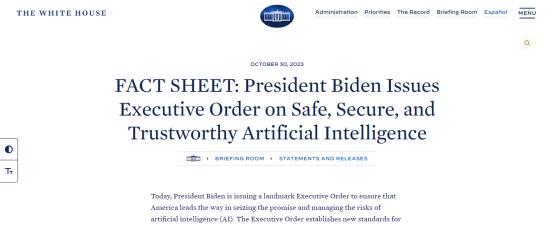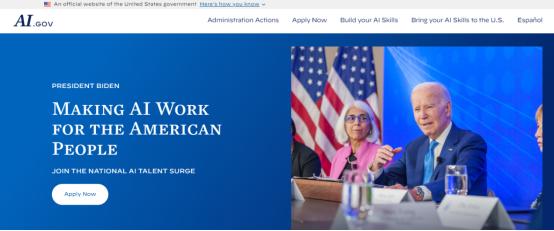U.S. Releases Most Comprehensive AI Regulatory Principles, Aiming to Lead Global AI Development Landscape
-
On October 30, 2023, U.S. President Joe Biden signed the most comprehensive artificial intelligence regulatory principles to date, directing all types of government agencies to ensure U.S. leadership in technological development while instructing agencies to establish standards to safeguard data privacy and cybersecurity, prevent discrimination, enhance fairness, and closely monitor the competitive landscape of the rapidly growing industry.
In Biden's own words, artificial intelligence is "the most consequential technology of our time."
This executive order, which has been in the works for months, represents the most significant effort to impose national order on this technology. The order will enable the U.S. to closely monitor the private sector's development of powerful AI systems. It includes requirements for companies to submit reports to the federal government detailing how they train and test so-called "dual-use foundation models," a category defined by the order that includes the most advanced new AI systems.

Here are the key points about this executive order:
This new administrative order surpasses the voluntary commitments made earlier this year by companies like OpenAI, Google, and Meta. However, it places greater emphasis on establishing best practices and standards rather than detailing how or even whether the new directives will be enforced. The order does not carry legal weight.
The order "calls upon" the National Institute of Standards and Technology (NIST) to develop standards for extensive "red team" testing—tests designed to break models and expose vulnerabilities—before their release. Yet, the executive order does not require AI companies to comply with NIST standards or testing methods. Many aspects of the order still rely on voluntary cooperation from tech companies.
However, the executive order will issue extensive directives to over a dozen agencies regarding their handling of AI systems, giving them 90 to 240 days to meet the order's requirements. The new guidelines empower federal agencies with market influence through procurement power and enforcement tools. President Biden's order specifically directs the Federal Trade Commission (FTC) to focus on anti-competitive behavior and consumer harm in the AI industry, a move already publicly endorsed by FTC Chair Lina Khan.
Meanwhile, Congress is actively working on legislation to address the risks and potential of AI. While some lawmakers hope to pass AI-related laws by year-end, Senate Majority Leader Chuck Schumer has indicated that comprehensive AI legislation may not emerge until next year.
The order highlights that the White House views the rapid development of foreign advanced cyber weapons as one of the most significant risks posed by AI, while also focusing on advancing domestic AI applications to detect vulnerabilities in U.S. government networks and counter adversaries' military use of AI.
On one hand, to prevent powerful AI models from falling into the hands of foreign adversaries, the order will require companies developing advanced AI models to submit regular reports to the Department of Commerce, outlining their plans to protect their technology from espionage or digital sabotage. It also mandates that major cloud service providers like Amazon and Microsoft notify the government whenever foreign entities rent server space to train large AI models.
On the other hand, the order includes directives for the National Security Council and the White House Office to draft a 'National Security Memorandum' to guide further actions on AI and security. This will ensure the safe, ethical, and effective use of AI by the U.S. military and intelligence community, as well as counter adversaries' military applications of AI.
The executive order emphasizes the importance of 'expanding bilateral, multilateral, and multi-stakeholder cooperation in AI,' aiming to position the U.S. as a global leader in AI policy. Prior to this order, the G7 reached an agreement on a code of conduct for companies developing advanced AI systems on October 29, as governments seek to mitigate the risks and potential misuse of the technology. The UK AI Safety Summit, scheduled two days later, will likely be influenced by this order, which may also encourage the EU to finalize its AI Act, as it sends a clear message that the U.S. aligns with many of the EU's policy goals.

As part of the order, the Department of Commerce will 'develop content authentication and watermarking guidelines' for AI-generated content, which AI companies will use to create labeling and watermarking tools that the White House hopes federal agencies will adopt.
These tools are widely proposed as solutions to AI-related issues such as deepfakes and misinformation, while also placing demands on intellectual property regulators and federal law enforcement to address the use of copyrighted works in AI training, including calls to "assess whether AI systems violate intellectual property laws."
In voluntary commitments announced to the White House in August this year, leading AI companies like Google and OpenAI pledged to develop such technologies. The challenge lies in the fact that watermarking and similar technologies are still under development. Currently, there is no fully reliable method to label text or determine whether content is machine-generated.
The White House has stated plans to collaborate with the "Coalition for Content Provenance and Authenticity" (C2PA initiative) to advance the development and adoption of these technologies. The coalition includes major companies like Adobe, Intel, and Microsoft and has designed a new internet protocol that uses encryption to encode information about content origins.
The draft executive order calls on the Director of the US Patent and Trademark Office and the Register of Copyrights to take additional administrative actions to "address issues related to copyright protection for AI-generated works and the use of copyrighted materials to train AI algorithms."
The draft order also directs each relevant agency to oversee AI business competition, monitor "risks arising from centralized control," and prevent dominant companies from further consolidating power.
Specifically, the executive order aims to help small businesses commercialize AI breakthroughs by providing technical assistance and resources to small developers and entrepreneurs, while encouraging the Federal Trade Commission to exercise its authority to promote a fair, open, and competitive AI ecosystem.
The cost of artificial intelligence is enormous. If only the largest companies like Google, Amazon, and Microsoft can compete, they may reinforce their monopolistic positions through AI development.
Notably, the executive order specifically acknowledges the Federal Trade Commission (FTC), whose chair has strongly indicated her intention to aggressively crack down on AI companies engaging in anti-competitive behavior. The order encourages the FTC to use its rule-making authority to enhance competition in the industry and protect consumers.

President Biden announced the launch of AI.gov at a press conference on October 30. This new website showcases the federal government's efforts and achievements in artificial intelligence (AI), while also providing resources and guidance for researchers, developers, and the public. This is part of the U.S. government's broader strategy in the AI field, aimed at promoting the development and adoption of AI in the country.
A key feature is the government's newly launched "National AI Talent Surge" portal, designed to rapidly recruit technical experts to build and manage AI systems in line with government values. The website also provides information on how the government is investing in AI research and development.
Attracting skilled workers is a major focus in the tech industry. The U.S. executive order outlines a comprehensive set of directives aimed at improving the ability of immigrants with AI expertise to obtain green cards or otherwise work for U.S. companies at the forefront of AI and emerging technologies.
The directive instructs multiple agencies, including the State Department, the Department of Commerce, and the White House Office of Science and Technology Policy, to conduct overseas activities promoting the U.S. as an attractive destination for foreign individuals with scientific or technical expertise to study, research, or work in AI and other critical technologies.
The executive order builds upon non-binding agreements between the White House and AI companies. The U.S. government's approach remains relatively friendly to tech companies, emphasizing innovation and competition rather than restrictions and constraints, further reflecting America's relatively relaxed stance on AI regulation. As a result, major tech companies have largely welcomed this executive order.
Microsoft Vice Chair and President Brad Smith praised it as "another critical step forward in the governance of AI technology."
Google's President of Global Affairs Kent Walker stated that the company looks forward to "constructive collaboration with government agencies to maximize AI's potential, including making government services better, faster, and more secure."
Adobe's General Counsel and Chief Trust Officer Dana Rao expressed: "It's great to see the White House investing in AI development by creating a framework for responsible AI practices."
Columbia Law Professor Bradford stated: "This executive order is probably the best we can currently expect from the U.S. government."
